The Pontius Pilate - Holy Grail and Druids in Scotland
Hospitaller Order of St. Lazarus of Jerusalem is also connected to
Mary Magdalen of Bethany - sister of Lazarus - and the Holy Grail
See Also: Mary Magdalen of Bethany - Sister of
Lazarus
Timeline:
1103BC - Arrival of Brutus
of Troy in Britain - The
island was then called Albion, and was inhabited by a few giants...Brutus called
the island after his own name 'Brit-ain'
and his companions 'Brit-o-ns' . He built a city which he called 'New
Troy,' Later, Lud, the brother of Cassibellaun made war
against Julius Caesar, and ordered it to be called after his own name,
'Kaer-Lud,' , the 'City of Lud' [or 'Lud-Dun,' corrupted
into 'Lon-don'].
723 BC - The kingdom
of Israel was invaded by Assyria
and the rest of the population deported.
~600BC - Siege of Jerusalem (587 BC)
- Babylonian captivity
- According to the Hebrew
Bible, there were three deportations of Jews to Babylon: the exile of King Jeconiah,
his court and many others in Nebuchadnezzar's
eighth year; Jeconiah's successor Zedekiah
and the rest of the people in Nebuchadnezzar's eighteenth year; and a later
deportation in Nebuchadnezzar's twenty-third year. These are attributed to c.
597 BCE, c. 587 BCE, and c. 582 BCE, respectively.
54BC - Caesar's
invasions of Britain - Lud
son of Heli - When he died, he was buried at Ludgate
- Crumbling statues of King Lud and his two sons, which formerly stood on the
gate, now stand in the porch of the church of St
Dunstan-in-the-West on Fleet
Street in London - Lud,
the brother of Cassibellaun made war against Julius Caesar, and
ordered it to be called after his own name, 'Kaer-Lud,' , the 'City of
Lud' [or 'Lud-Dun,' corrupted into 'Lon-don']. -
Caesar doesn't stay
43AD - Claudian
invasion, an army of 40,000 professional soldiers - half citizen-legionaries,
half auxiliaries recruited on the wilder fringes of the empire - were landed in
Britain under the command of Aulus Plautius
44-69AD - The 70
disciples of Jesus Christ - Lazarus
and Mary Magdalen landed at the place called Saintes-Maries-de-la-Mer
near Arles - France
60-61AD - Romans
annihilate the Druids in Anglesey - Bitterness
against Roman oppression had driven Boudicca, queen of the Iceni tribe, into a
revolt that came close to expelling the invaders.
62AD - Joseph
of Arimathea with 12 missionaries landed on the Isle of Britain in 62 AD.
- Philip
the Apostle sent twelve Christians to Britain, one of whom was, Joseph of
Arimathea
70AD - Destruction of
Jerusalem by Titus - 1,000,000 Jews perished - survivors sold into
slavery - Solomon's temple destroyed
410 - Romans
leave Britain
442 - Britain falls
under the rule of the Saxons
Jesus wore the robes of a Druid:
 House of Danu - Ritual Clothing
- What Did the Ancient Druids Wear? - P.W.
Joyce, in A Social History of Ancient Ireland, describes the druids as wearing
white robes or tunics, based on notes by Tirechan about Rechrad the Druid of
Amalgaid, and those in attendance with him when an attempt was made to kill
Saint Patrick.
House of Danu - Ritual Clothing
- What Did the Ancient Druids Wear? - P.W.
Joyce, in A Social History of Ancient Ireland, describes the druids as wearing
white robes or tunics, based on notes by Tirechan about Rechrad the Druid of
Amalgaid, and those in attendance with him when an attempt was made to kill
Saint Patrick.
Jesus was a Galilean.
That much we know. The question of who exactly the "Galileans" were
during Biblical times is a much more complicated matter
Gaelic
is an adjective that means "pertaining to the Gaels",
including language and culture. As a noun, it may refer to the group of
languages spoken by the Gaels, or to any one of the languages individually
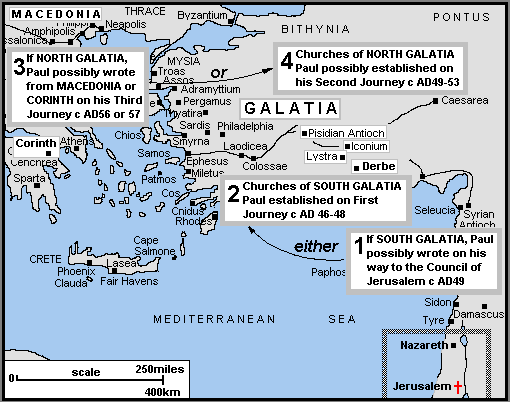
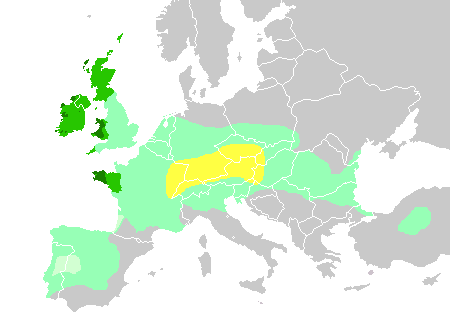
Map of the Celts in Europe - The spot on the far right is Galatia
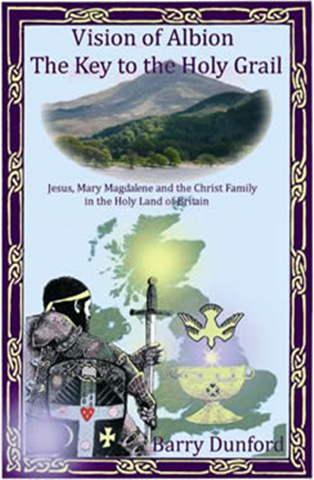 VISION OF ALBION THE KEY TO THE HOLY GRAIL
VISION OF ALBION THE KEY TO THE HOLY GRAIL
Jesus, Mary Magdalene and the Christ Family in the Holy Land of Britain
Barry Dunford
(published December 2008)
Contents include:
The spiritual role of the sacred isles of Britain in world history
Were Jesus and Mary Magdalene on Iona?
Was there a female Apostolic succession?
Pontius Pilate and the ancient yew at Fortingall
Rosslyn Chapel and the Rose lineage of Christ
Did Jesus Visit Scotland?
Was Pontius Pilate a Scot?
[ Some of Jesus lost years may have been spent
in Scotland (possibly knew Pilate?)
Here is a good video from Barry Dunford ]
Historical & Spiritual Destiny of British Isles, part 1 -
Video
Talk by Barry Dunford at the Stars & Stones Conference, England, 2009.
Sacredconnections.co.uk
The English visionary poet and mystic, William Blake,
asserted that Albion, the most ancient name for the British Isles, was actually
the original and true Holy land of Christ, and Barry Dunfords revealing
illustrated presentation demonstrates that there is genuine substance to this
intriguing notion. Drawing on a wealth of reference source material, he
investigates Blakes mystical vision of Albion as the true Holy Land of the
Christ.
By deciphering clues from gaelic place names, together with well established
regional traditions and legends, Barry Dunfords research supports the Blakean
thesis of Jesus Christs presence in these islands. He also demonstrates that
other members of the Holy Family are also likely to have travelled to Britain
Historical
& Spiritual Destiny of British Isles, part 2 - Video
| - - - - -
Monarch of Antiquity -
The Sacred Yew Tree in the Heart of Scotland
By
Barry Dunford
Located close to the geographical centre of Celtic Scotland is to be found
a remarkable yew tree which is currently believed to be around 5,000 years of
age, thus dating its origins to about 3,000 B.C. This yew is to be found in
Fortingall, Perthshire, which lies at the entrance to Glenlyon, the longest
and arguably the most spectacular glen in Scotland. When the 18th century
traveller and naturalist Thomas Pennant (1726 - 1798) visited Fortingall, he
reported that the girth of this age old yew was fifty six and a half feet. One
can but wonder what is giving life force to this extraordinary aged yew tree
which can still be seen to be thriving at the present time, and is reputedly
the oldest tree in Europe.
...
According to ancient lore it would appear that the yew was seen as an
arcane repository, i.e. a tree of knowledge. It has also been noted that yew
trees were often associated with ancient hill forts and, true to form, on an
elevated position close by the Fortingall Yew is to be found the remains of
an old hill fort called Dun Geal which translates from the gaelic as 'the
white fort'. At the time of Christ, Dun Geal was the residence of the
Caledonian King, Metallanus, of whom local tradition claims Pontius Pilate
was a relative.
Aerial photographs of Fortingall reveal a marking in the landscape which
is believed to indicate the enclosure or vallum of an early Christian
monastic site. This monastic settlement appears to have been centered around
the Fortingall Yew tree. Such is the reputation of this remarkable Yew that
in 1993 a sapling from this archaic tree was planted in Glastonbury Abbey,
while concurrently monks from the Tibetan Buddhist monastery, Samye Ling, in
Dumfriesshire, Scotland, planted another sapling on Holy Island, off the
coast of Arran, Scotland. More recently cuttings were taken from the
Fortingall Yew to be grown by the Forestry Commission at Roslin, another
historical sacred site in Scotland. These yew cuttings will eventually be
planted around the country at such places as the arboretum at Scone Palace.
Interestingly, Scone was at one time home to the famous "Stone of
Destiny" which was central to the Coronation ceremony of the old
Scottish Kings.
...
There is a tradition that the Cross of Christ was a yew tree probably because of its symbolism of immortality. This may explain the following observation: "Although the Yew was planted on temple sites, and was a survival of cultus arborum (tree worship) yet, strange to say, it was never damaged, but
was adopted by the Christians as a holy symbol." (The Church Yew & Immortality by Vaughan Cornish). Furthermore, the yew also figures in the folklore of the gypsies who believe that the planting of a yew near one's home provides protection. Interestingly, about a century ago gypsies were found to be living in the hollow churchyard yew at Leeds in the English county of Kent.
Barry Dunford
- EzineArticles.com Expert Author
Book
Reviews: Spirituality Religion •
Published: April 16, 2010
The English visionary poet and mystic, William Blake,
believed that Albion, the most ancient name for the British Isles, was the
original and true Holy Land of Christ. In my well documented book "Vision
of Albion: The Key to the Holy Grail" I show there may be some substance to
such an intriguing notion. Drawing on historical source material I have
investigated Blake's mystical vision of Albion as the Holy Land of Christ, which
is inextricably linked with the English poet's intuitive feeling expressed in
his famous lines - And did those feet in ancient time, walk upon England's
mountains green? And was the Holy Lamb of God, on England's pleasant pastures
seen?
Reference
and Education: Nature • Published:
April 11, 2010
Located close to the geographical centre of Celtic
Scotland is to be found a remarkable yew tree which is currently believed to be
around 5,000 years of age, thus dating its origins to about 3,000 B.C. This yew
is to be found in Fortingall, Perthshire, which lies at the entrance to Glenlyon,
the longest and arguably the most spectacular glen in Scotland. When the 18th
century traveller and naturalist Thomas Pennant (1726 - 1798) visited Fortingall,
he reported that the girth of this age old yew was fifty six and a half feet.
| - - - - -
Jesus:
The Explosive Story of the 30 Lost Years and the Ancient Mystery Religions
[Paperback]
Tricia McCannon
| - - - - -
This seems to connect to the Grail story:
I attended a bible study nights, a phase of my life when younger so to
say.
The point, we (students) were told
the throne of England, the original, wood
carved baby is carved w/ hebrew writings. T or F.
The professor ,also explained, valid or not I can't say. The fable of the lost tribe of Israel, the fishing village inhabitants
that took of from Israel ended up in Ireland (freedom). I know, off
subject, just thought I', toss it in there. ...
There are Phoenician/Hebrew origins in Britain/Ireland/Scotland. ....
downloadable book:
see: The
Phoenician Origin of Britons, Scots & Anglo-Saxons - Lawrence Austine
Waddell 1925
In 43 AD the Roman Empire of Claudius invaded
England - Again Nothing could be left to chance - 40 thousand troops were sent
across the channel:
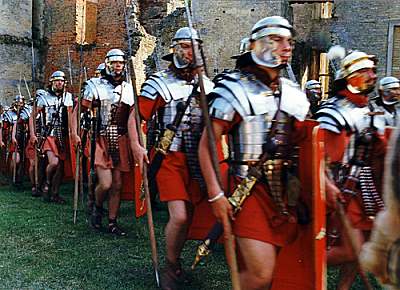
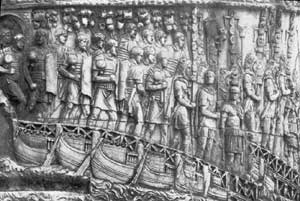
The Romans in Britain
...
The Romans invaded England again in 43 AD under Emperor Claudius. The Roman
invasion force consisted of about 20,000 legionaries and about 20,000 auxiliary
soldiers from the provinces of the Roman Empire. Aulus Plautius led them.
The Romans landed somewhere in Southeast England (the exact location is unknown)
and quickly prevailed against the Celtic army.
...
Roman
Conquest of Britain
...
In 43AD, possibly by re-collecting Caligula's troops, Claudius mounted an
invasion force to re-instate Verica, an exiled king of the Atrebates.[6] Aulus
Plautius, a distinguished senator, was given overall charge of four legions,
totalling about 20,000 men, plus about the same number of auxiliaries
Is it true that Pontius Pilate was a Scot trained
by the Druids? .... So why did Claudius want Britain so bad?
Later in 60 AD the Romans invaded Anglesey and WIPED OUT the Druids there.
It is thought that the Druids were in contact with the Mediterranean Essenes and
wanted Pilate in place to be in Jerusalam and watch out for Jesus - didn't quite
work out - but Pilate didn't send Jesus to the gallows either
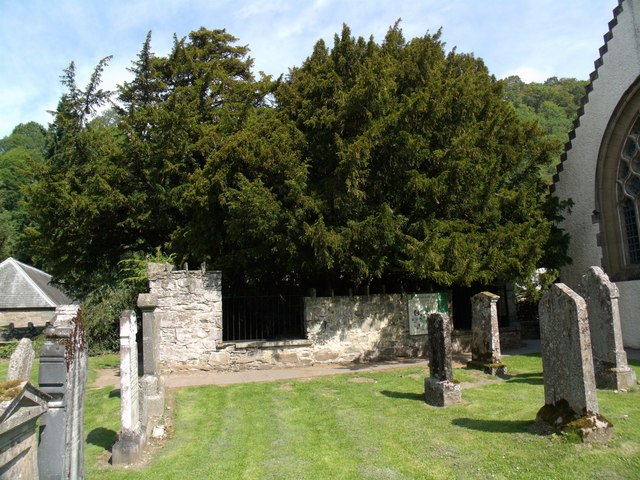
The Fortingall Yew - This famous yew tree is estimated to be approximately
5000 years old and is believed to be the oldest living thing in Europe.
Pontius Pilate
on Undiscovered Scotland
...
There has long been a story that Pontius Pilate was actually born at
Fortingall in Perthshire, also known as home to an ancient yew tree that could
be as much as 5,000 years old (and, if so, is probably the oldest living
thing on Earth). At first sight the story of Pilate's birth here looks unlikely.
The Romans arrived in southern Britain in 55BC, but only briefly. They
returned to invade what is now England in AD43, and only invaded Scotland for
the first time in AD80, reaching the area including Perthshire in about AD83.
Against this background, how could a Roman have been born here in, roughly, the
decade either side of 20BC, which seems necessary to have allowed him to become
Prefect of Judaea in AD26?
The story of Pilate's Scottish origins was set out most fully in an
article published in the New York Times on 15 January 1899. It seems that
between the Romans' first incursion into Britain and their later invasion,
Ceasar Augustus dispatched envoys to establish diplomatic relations with some of
the important British and Caledonian chieftains. These included a Caledonian
chieftain called Metellanus, whose stronghold was at the head of Glen Lyon. A
member of the Roman delegation to Metellanus's tribe fathered a child with a
Caledonian woman, and this child subsequently returned to Rome with his father
(and, possibly, his mother), and was brought up as Pontius Pilate
see: Fortingall Yew tree
Pontius Pilate was born at Fortingall, which translates from the gaelic
placename 'Feart-nan-Gall' as the 'Stronghold of the Strangers' (The druids).
Nowhere else in Scotland, or for that matter in the British Isles, has an
oral tradition and association with the birth of Pontius Pilate; so why should
the tiny and obscure hamlet of Fortingall lay claim to this tradition, unless
there is an intrinsic element of truth in what would otherwise be deemed as an
audacious presupposition.
The yew is a primordial tree and it is believed to date back for at least two
hundred million years, which considerably antedates the era of the human race.
It is no wonder that from time immemorial the eternal yew appears to have been
seen as the immortal tree of life and held with sacred reverence throughout
the ages.
According to ancient lore it would appear that the yew was seen as an arcane
repository, i.e. a tree of knowledge. It has also been noted that yew
trees were often associated with ancient hill forts and, true to form, on an
elevated position close by the Fortingall Yew is to be found the remains of an
old hill fort called Dun Geal which translates from the gaelic as 'the
white fort' (and the druids wore white) . At the time of Christ, Dun Geal
was the residence of the Caledonian King, Metallanus, of whom local tradition
claims Pontius Pilate was a relative.
Commenting on the Fortingall Yew, Vaughan Cornish, D.Sc., in his book The
Churchyard Yew & Immortality (1946) remarks: "Of Yew trees in the
churchyards of Scotland the most celebrated is that of Fortingall in Perthshire.
The tree as measured in A.D. 1771 by Thomas Pennant was 56 1/2 feet in
circumference and as measured by Daines Barrington in A.D. 1769, 52 feet, thus
being greater than that of any churchyard Yew of England or Wales. This led to
the supposition that of all the trees in Britain the Fortingall Yew was monarch
of antiquity. Upon this belief legends grew. One of these was embodied in a poem
by W. Cowan, from which the following is a quotation:
'Here Druid priests their altars placed,
And sun and moon adored.
* * * * * * *
A tree - the sacred Yew,
Symbol of immortality -
Beside their altar grew.'
Reference:
The Magic Arts in Celtic Britain
Historic
scenes in Perthshire
By William Marshall
The Roman Empire was a global slave system -
the beginning of it's collapse was seen in 410AD
The sack of Rome was made by those who were targets of enslavement.
Sack
of Rome (410AD)
The Sack of Rome occurred on August 24, 410. The city was attacked by the
Visigoths, led by Alaric I.
 At that time, Rome was no longer the capital of the Western Roman Empire,
replaced in this position initially by Mediolanum and then later Ravenna.
Nevertheless, the city of Rome retained a paramount position as "the
eternal city" and a spiritual center of the Empire. The sack was to
prove a major shock to contemporaries, friends and foes of the Empire alike.
At that time, Rome was no longer the capital of the Western Roman Empire,
replaced in this position initially by Mediolanum and then later Ravenna.
Nevertheless, the city of Rome retained a paramount position as "the
eternal city" and a spiritual center of the Empire. The sack was to
prove a major shock to contemporaries, friends and foes of the Empire alike.
This was the first time in almost 800 years that Rome had fallen to an enemy.
The previous sack of Rome had been accomplished by the Gauls under their leader
Brennus in 387 BC. The sacking of 410 is seen as a major landmark in the fall
of the Western Roman Empire.
St. Jerome, living in Bethlehem at the time, wrote that "The City which
had taken the whole world was itself taken."
...
Barbarian tribes grew stronger for some time, and united themselves to
challenge Roman hegemony.
In the late 4th century, however, the Huns began to overrun barbarian
territories. In 376, they forced many Thervings, led by Fritigern, to seek exile
into the Eastern Roman Empire. Soon after, high taxes, Roman prejudice, and
government corruption turned them against the Empire. ...
Sack of Rome by the Visigoths on 24 August 410 by Joseph-Noël Sylvestre
Aftermath
After the sack, Alaric and his forces journeyed south, where they expected to
take ships to Africa. The ships were destroyed, however, in a storm and Alaric
died around the same time.
Ataulf took command of the Goths, leading them north into Gaul, where they
settled in Aquitaine. This sack of Rome is generally considered to mark the
end of classical history with the Middle Ages thereupon commencing,
characterized by the rise of small feudal regions rather than one unitary empire
and Christian chivalry as opposed to secular investigation. In truth, of course,
the matter is more complicated, as scientific inquiry continued to some degree
during the Middle Ages and the Byzantine Empire (or Eastern Roman Empire)
continued for a further 1000 years.
When the Romans left Britain in 410AD - the people
had been so disarmed, enslaved and domesticated that is was left exposed to
invasions from Picts and Anglo-Saxons. There was no longer any native militia to
stop the onslaught.
End
of Roman rule in Britain - The end of Roman rule in Britain is the period during which the Roman
Empire ended its relationship with Roman Britain, thus marking the transition
from Roman Britain to post-Roman Britain. No single date is correct without
qualification, as Roman rule ended for different parts of Britain at different
times, and under different circumstances.
The year 410 is the preference of most historians. In that year, the Roman
Emperor Honorius replied to a request for assistance with the Rescript of
Honorius, telling the Romano-Britons to see to their own defence. Some
historians prefer 409 instead, the year when the Romano-Britons expelled Roman
magistrates from their cities
...
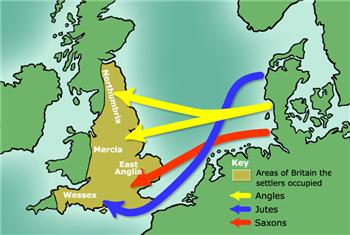
Germanic tribes invasion - Roman Britain ends 410
Roman Britain was attacked by Angles, Saxons and Jules who were tribes from
North Germany, Denmark & Holland. Roman called them "barbarians".
In 410 AD, last Romans left Britain
Hebrew and English
...
SUMMARY
The research of other scholars also substantiates this evidence. For example,
famed Celtic scholar, John Rhys, in The Welsh People, speaks of,
"convincing evidence of the presence of some element other than Celtic...
We allude to an important group of Irish names formed much in the same way as
Hebrew names are represented in the Old Testament. " (p. 66) Many of these scholars
further assert that the Celtic ancestors of the modern English people spoke a
language which was strongly influenced by both Hebrew and Egyptian down to its
very root structure. Yet only the ancient Israelites of the Bible, fresh
from hundreds of years of Egyptian captivity, would exhibit such a unique
language style
Historians have often written about the "Phoenician" ships that
sailed the Mediterranean Sea to Britain in early times, but few relate the
connection between the Hebrew and Phoenician languages.
The Bible Handbook by Dr. Joseph Angus, D.D., states, "That the Hebrew
language was the common tongue of Canaan and Phoenicia is generally admitted.
" (p. 13) In our tract, "Ancient Hebrew Sea Migrations," we
show that a significant portion of the so-called Phoenician trade was in reality
Israelite. Knowledge of this little-known history sheds important light on
Bible history and prophecy
| - - - -
But what is interesting is what British
royalty "believe" .... and this idea came into existence at the same time period
(1870-1880's) as the origin of zionism ... hmmm.....
British
Israelism
British Israelism (also called Anglo-Israelism) is the belief that
people of Western European descent, particularly those in Great Britain, are the
direct lineal descendants of the Ten Lost Tribes of Israel.
The concept often includes the belief that the British Royal Family is
directly descended from the line of King David.[1][2] There has never been a
single head or an organisational structure to the movement. However, various
British Israelite organisations were set up across the British Commonwealth and
America from the 1870s, and many still continue to exist.
...
British Royal Family
James I of England (1567–1625) believed he was a king of Israel.
In 1996, The Independent, reprinted the facsimile of a 1922 letter by George
VI (then Duke of York). He wrote:
...I am sure the British Israelite business is true. I have read a lot
about it lately and everything no matter how large or small points to our being
’the chosen race.’ [72]
Princess Alice, Countess of Athlone was a chief patron of the
British-Israel-World Federation from 1920 until her death. Her daughter Lady
May Abel Smith was also a patron of the Federation until her own death in
1994.[73]
It is also claimed by modern British Israelites that Queen Victoria believed
herself she descended from King David, they quote a letter she wrote
supposedly supporting this view that she occupied the throne of David
The Stone of Jacob appears in the
Book of Genesis as the stone used as a
pillow by the Israelite patriarch Jacob at the place later called Bet-El. As
Jacob had a vision in his sleep, he then consecrated the stone to God. More
recently, the stone has been claimed by Scottish folklore and British Israelism.
THE CORONATION STONE

WHO OWNS THE ROCK?
The coronation stone which sat in Westminster Abbey, England, is the
coronation stone of the Hebrew nation called Israelites. This stone was named
Beth-el (house of God) by the patriarch Israel (sometimes called Jacob) roughly
2000 BC and remained with his descendents. It travelled with them for forty
years in the wilderness, supplying their water, and was preserved and brought to
Ireland in 583 BC by the prophet Jeremiah; eventually being transferred to
Scotland, then England, and now resides in Scotland.
...
ENGLAND'S CORONATION CHAIR
The Coronation Chair of England has been in constant use to crown the
Monarchs of England since 1296 AD when Edward I had it constructed for his
coronation. The chair was built specifically to house the Coronation Stone which
Edward brought from Scotland. It had resided there since being brought by Fergus
from Ireland in 500 AD.
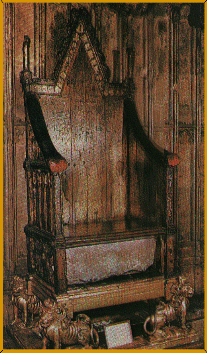
Stone
of Scone -
The Stone of Scone ( Scottish Gaelic: An Lia Fàil), more
commonly known as the Stone of Destiny and often referred to in England as
the
Coronation Stone, is an oblong block of red sandstone, used for centuries in the
coronation of the monarchs of Scotland and later the monarchs of England, Great
Britain and the United Kingdom.
Historically, the artifact was kept at the
now-ruined Scone Abbey in Scone, near Perth, Scotland. Other names by which it
has sometimes been known include Jacob's Pillow Stone and the Tanist
Stone, and
in Scottish Gaelic clach-na-cinneamhain. Its size is about 26 inches (660 mm) by
16.75 inches (425 mm) by 10.5 inches (270 mm) and its weight is approximately
336 pounds (152 kg). The top bears chisel-marks. At each end of the stone is an
iron ring, apparently intended to make transport easier.
King Edward's
Chair
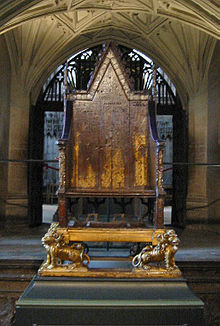
King Edward's Chair, sometimes known as St Edward's Chair or The Coronation
Chair, is the throne on which the British monarch sits for the coronation. It
was commissioned in 1296 by King Edward I to contain the coronation stone of
Scotland — known as the Stone of Scone — which he had captured
from the Scots who had kept it at Scone Abbey. The chair was named after
Edward the Confessor, and was kept in his shrine of St Edward's Chapel at
Westminster Abbey.
see also:
Exodus 2006 -
Lia-fail Code Searches
“Lia-fail” is also known as “the Stone of Scone”, “Jacob’s
Pillow Stone”, “Jacob’s Pillar Stone”, and the “Coronation Stone”.
It is thought by many to be the stone that Jacob used for a pillow when
camping at Luz where Jacob had his first encounter with the LORD:
“ And Jacob went out from Beersheba, and went toward Haran. And he lighted
upon a certain place, and tarried there all night, because the sun was set; and
he took of the stones of that place, and put them for his pillows, and lay down
in that place to sleep. And he dreamed, and behold a ladder set up on the earth,
and the top of it reached to heaven: and behold the angels of God ascending and
descending on it. And, behold, the Lord stood above it, and said, I am the Lord
God of Abraham thy father, and the God of Isaac: the land whereon thou liest, to
thee will I give it, and to thy seed; And thy seed shall be as the dust of the
earth, and thou shalt spread abroad to the west, and to the east, and to the
north, and to the south: and in thee and in thy seed shall all the families of
the earth be blessed. And, behold, I am with thee, and will keep thee in all
places whither thou goest, and will bring thee again into this land; for I will
not leave thee, until I have done that which I have spoken to thee of. And Jacob
awaked out of his sleep, and he said, Surely the Lord is in this place; and I
knew it not .And he was afraid, and said, How dreadful is this place! this is
none other but the house of God, and this is the gate of heaven. And Jacob rose
up early in the morning, and took the stone that he had put for his pillows, and
set it up for a pillar, and poured oil upon the top of it. And he called the
name of that place Bethel: but the name of that city was called Luz at the
first. And Jacob vowed a vow, saying, If God will be with me, and will keep me
in this way that I go, and will give me bread to eat, and raiment to put on, So
that I come again to my father's house in peace; then shall the Lord be my God:
And this stone, which I have set for a pillar, shall be God's house: and of all
that thou shalt give me I will surely give the tenth unto thee.”
Genesis 28.10-22
...
Most of the legends have the stone being removed from Jerusalem by Jeremiah
and his scribe Baruch just before the Babylonian invasion. The Bible records
them going to Egypt with King Zedekiah’s daughters (Jeremiah 41.11-18) but
doesn’t mention the stone.
The stone ended up in Ireland, where the princesses were married to Irish
royalty and was later transferred to Scotland, and eventually captured and taken
to England about 700 years ago where it has been used to crown every king and
queen since
see also: downloadable book: The
Coronation stone By William Forbes Skene
Fal's Fiery Stone - Lia Fail of the Irish Celts - Serpent-cult people
called "The tribe of the goddess Danu" (Tuatha de Danaan), who,
significantly also are stated to have migrated to Ireland from Alban....the
prehistoric Feins in Ireland is of great importance for the origin of the
prehistoric Serpent cult in Ireland...And Fal's Fiery Stone was the
materialized thunderbolt of the Dragon serpent of Lightning, ... So
intimately was Fal identified with the early Ireland of the Feins that Erin was
called "Fal's Isle" (Inis Fall); and "Fal's Hill" was the
title of the sacred hill at the ancient capital, Tara.
Ancient Knights
Templar by Kelly d. Whittaker
The Templar today is a large part of the Scottish Rite. The Rite stems from Freemasonry. Knights Templar is associated largely with the Catholic Church
but that is not how the Order of the Templar began
...
Joseph of Arimathea, a very wealthy member of the Zealots, claims Jesus' body at the cross. Joseph then places the body of Jesus in a tomb that is owned by the Arimathea. A certain group of people make friends with Joseph because of his compassion to the Messiah.
The new friends were people such as, James the Justus-Jesus' brother, Apostle Peter, Mary-Jesus' mother and Mary Magdalene. Joseph made quite an impression on the group. He was able to obtain the Cup of Christ, the lance that pierced Jesus' side and Peter's copy of Jesus'
laws.
The early Church of the Christ considered Joseph of Arimathea a very important and blessed man. Apostle Peter had been crucified (upside down) and most of the apostles were dead. Joseph knew he had to get the young church out of Jerusalem to safety. When he organized the departure out of Israel, many people followed
him.
Mary Magdalene had gotten married and gave birth to three children. The children were named, Tamar, Jesus the Justus, Joseph or Josephes. There is a controversy over the father of Mary's children.
The eldest son is named Jesus Justus therefore pointing to James the Justus as being the possible
father. James the Justus was the brother to Jesus the Christ.
James having children kept the avenue open for a possible bloodline King of Judah. After all, Joseph (James' father and Jesus' earthly father) was a direct descendent of King
David.
Joseph of Arimathea with 12 missionaries landed on the Isle of Britain in 62 AD.
Mary Magdalene with her children and some female companions took refuge at Rennes le Chateau which is located in Arcadia.
The same area that the Tribe of Benjamin settled when they were exiled from
Israel.
Arimathea had possession of the Holy Relics as was searching for a strong hold to house them.
King Avallach of Sarras became known as Mordreins meaning Slow of Belief, took Joseph and the Grail Keepers to his home named Peel Castle.
Peel Castle was situated in the Land of Glass. The Grail keepers were represented by a red cross. This began with Joseph of Arimathea. We find more evidence of the "Grail Keepers" nearly 400 years later.
Lancelot, Sir Gawain and Perceval all bore the red cross on their shields. The Keepers were a religious military order that was sworn to poverty and obedience to the Grail
beliefs. They along with the Grail Kings wanted to regain the power that Benjamin once had in Israel.
The plan was to place a man of the Holy Bloodline as the King of Judah.
The Grail Kings were allowing the time needed to implement such a strategic plan, by beginning their own Christian teachings and
beliefs. Joseph of Arimathea had came against the most stubborn civilization to convert so he compromised with these people. These people were the Celts. They did not want to give up their belief of 'finding the light.' Joseph used this to his advantage for Jesus the Christ was known as 'the light.'
The Romans tried to force their church on the Celtic Christians, therefore leading to one of the most famous legends of all time, King Arthur and
Modred. While the war of religion was on again, the Templar remained very secretive.
They protected the gifts of Joseph of Arimathea. They only allowed those whom they felt worthy to see the Holy Relics. This became known as the Fisher Kings. A very humble passive group of men to carry on the Grail
Tradition. The Templar served the Celtic Church until the Twelfth Century. The Plan was still surviving at this time. The Templar grew wealthy and powerful. A much stronger influence came into the soul of the Grail teachings and the Knights Templar, the Roman Catholic Church...
| - - - - -
Dunstan, Abbot of Glastonbury,
had, at an early period of his life, been admitted into that ancient monastery,
which was then also a school or college. Glastonbury was principally
filled by Scots, or monks from Ireland.
So here is more evidence that St.
Dunstan was recruiting young monks for the clergy - for good or bad, he brought
the Benedictine order to England under the reign of King Edgar. Priests
stripped of wife and family would be completely dependent upon the church and
would be much more obedient to Rome. Interestingly, this was still not enough
for Rome. In 1066, William the conqueror was given permission from the Pope to
invade England and with him he brought Norman priests even more loyal to the
pope (William was borrowing money from everyone even the Pope/Lombards).
Also another example of Britains'
early worship of Mary Magdalene and Lazarus prior to the crusades (This was a
Norman church built just after the conquest and prior to the crusades (and
against the Cathars), The Normans of France certainly had exposure to the
Cathars of Provence, France.
The Cathers Language: Occitan
language is a Romance
language spoken in southern
France, Italy's Occitan
Valleys, Monaco,
and Spain's Val
d'Aran: the regions sometimes known unofficially as Occitania.
It is also spoken in the linguistic enclave of Guardia
Piemontese (Calabria,
Italy). Related - The Cat People: Catalan
language
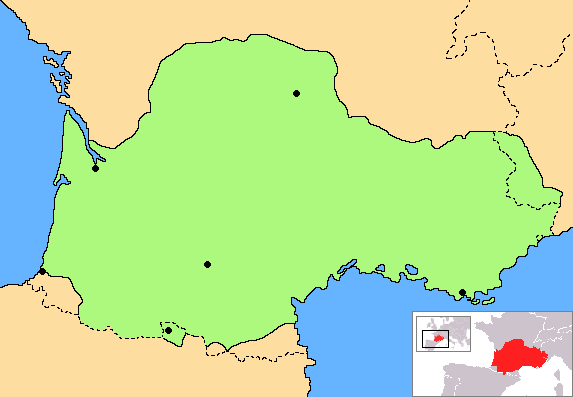 Linguistic
map of Occitania
Linguistic
map of Occitania
Notice also that Glastonbury was
occupied with priests from Ireland:
The
collected historical works of Sir Francis Palgrave

Chichester
Cathedral - The Cathedral Church of the Holy Trinity, otherwise
called Chichester Cathedral, is the seat of the Anglican
Bishop of Chichester. It is located in Chichester,
in Sussex, England.
It was founded as a cathedral in 1075, when the seat of the bishop was
moved from Selsey...
Chichester Cathedral was built to replace the cathedral founded in 681 by St.
Wilfrid for the South
Saxons at Selsey.
The seat of the bishop was transferred here in 10
Selsey was the capital
of the South
Saxons kingdom, possibly founded by Ælle.
Wilfrid
arrived circa 680 and converted the kingdom to Christianity, as recorded by the
Venerable Bede.[22]
Selsey
Abbey stood at Selsey (probably where Church
Norton is today),[23]
and was the cathedral
for the Sussex
Diocese until this was moved to Chichester in 1075 by order of William
the Conqueror
139
Dunstan, Abbot of Glastonbury, had, at an early period of his
life, been admitted into that ancient monastery, which was then also a school or
college. Glastonbury was principally
filled by Scots, or monks from Ireland.
...
The popes of Rome were, about this time, most earnest in compelling the celibacy
of the clergy. In the Anglo-Saxon empire, this regulation had never yet been
enforced upon the inferior orders of the hierarchy. The principle upon which
the prohibition was founded, arose from a mistaken application of passages of
Scripture, appearing, when separated from their context, to justify a
restriction, which, if imposed as a yoke upon men's consciences, was wholly in
contradiction to the spirit of the Gospel. Considered, however, as a matter of
discipline and expediency, there were reasons of policy which might then render
it in some degree advisable. In the middle ages, when all the institutions of
society had a strong tendency to the establishment of hereditary right, and when
there was little written law, any usage or custom which had subsisted for two or
three generations, easily acquired the validity of positive legislation. Lands
had been granted to the clergy for their maintenance. A married priesthood would
soon have degenerated into a caste of sacerdotal nobility, holding their lands
as a patrimonial inheritance by the nominal condition of serving at the altar,
but neglecting, in fact, every duty which they were charged to perform.
143 Benedictine Order
955-973
At an earlier period, this state of things had been sufficiently realized in
Northumbria, to shew the nature and extent of the imminent danger by which the
church was threatened. If the system had prevailed, the spiritual ministration
of religion would have been debased, the temporal advantages resulting to the
community from the establishment of Christianity would have been wholly
destroyed; therefore, we can well suppose, that many thinking men, honestly
anxious for the real interests of religion, would labour for the prevention of
such an abuse. Most closely connected with this question of celibacy, was the
introduction of the Benedictine rule among the monks of England1.
Before Dunstan's time, each congregation of recluses lived according to
its own internal regulations, nor were the several monasteries consolidated into
one community.
A Roman of the name of Benedict, a man of sincere piety, had introduced a
new code into the monastery which he founded upon Monte Cassino, in the
ancient territory of the Samnitesa. Amongst much that was trifling, it contained
more that was well adapted to increase the utility of the monastic life, and to
restrain its vices, being particularly adapted to prevent the cloister from
becoming a nestling place of sloth and profligacy. These monasteries, upon the
continent, had united into one corporation. The Benedictines of Italy were
members of the same body as the Benedictines of Gaul. They were exempted from
the jurisdiction of the bishops, and placed under a "General" of their
own; and they soon became the ready instruments of papal ambition.
The great object sought by the popes was the suppression of the independence
of the different national churches of Christendom; and the celibacy of the
clergy became a party badge—a pledge of submission to the Church of Rome,
if yielded,—a token of hostility, if refused. And in this spirit of
conquest did Dunstan, and those who co-operated with him, engage in the plans
which they pursued.
The Scottish or Irish, and Pictish and British churches, though in communion
with Rome, were still independent of the papal see. The Anglo-Saxon church
was more inclined towards subjection, and the Benedictine rule had been
introduced at Glastonbury. Yet the opposition was very strong.
...
146
The married clergymen, who refused to separate from their wives, were
driven out by main force. Some, perhaps, were bribed into compliance by
the king's [ Edgar ] bounty. As soon as a body of monks was established in any
given church, large and ample donations were bestowed upon the new colony.
Such of the old English monks as had not yet received the Benedictine
rule, were induced to fraternize with Monte Cassino, either by approbation
of the real merits of the system—for merits it certainly had—or in order to
conciliate the king. During the Danish invasions and the consequent troubles,
many of the endowments of the monasteries had been seized or acquired by the
nobles and other laymen. Edgar often succeeded in persuading these persons to
restore the property, which they could not hold with a good conscience. In other
instances, if a stubborn "thane" resisted the persuasions of the
monarch, and had made up his mind to despise the anathemas denounced against the
usurpers of church property, Edgar purchased the land with his own money, and
restored it to the church. By these means, before the close of the reign of
Edgar, forty-eight opulent Benedictine monasteries of monks and nuns were
established in Anglo-Saxon Britain; and these subsisted until the era fatal
to all similar foundations.
 House of Danu - Ritual Clothing
- What Did the Ancient Druids Wear? - P.W.
Joyce, in A Social History of Ancient Ireland, describes the druids as wearing
white robes or tunics, based on notes by Tirechan about Rechrad the Druid of
Amalgaid, and those in attendance with him when an attempt was made to kill
Saint Patrick.
House of Danu - Ritual Clothing
- What Did the Ancient Druids Wear? - P.W.
Joyce, in A Social History of Ancient Ireland, describes the druids as wearing
white robes or tunics, based on notes by Tirechan about Rechrad the Druid of
Amalgaid, and those in attendance with him when an attempt was made to kill
Saint Patrick. 





 At that time, Rome was no longer the capital of the Western Roman Empire,
replaced in this position initially by Mediolanum and then later Ravenna.
Nevertheless, the city of Rome retained a paramount position as "the
eternal city" and a spiritual center of the Empire. The sack was to
prove a major shock to contemporaries, friends and foes of the Empire alike.
At that time, Rome was no longer the capital of the Western Roman Empire,
replaced in this position initially by Mediolanum and then later Ravenna.
Nevertheless, the city of Rome retained a paramount position as "the
eternal city" and a spiritual center of the Empire. The sack was to
prove a major shock to contemporaries, friends and foes of the Empire alike.




